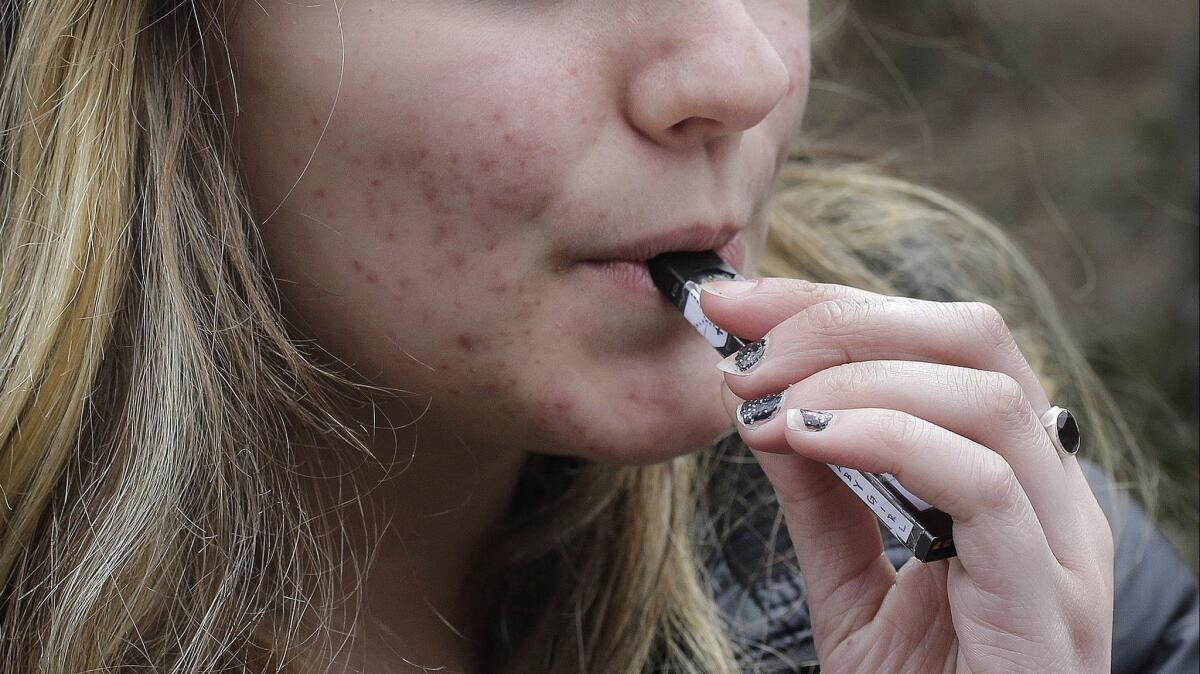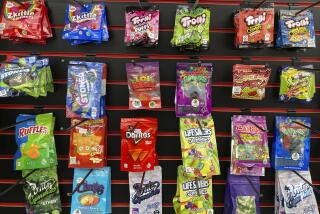More than 1.3 million high school students started vaping nicotine in the last year, study says

The proportion of U.S. high school seniors who are vaping tobacco products nearly doubled in the past year, with more than 1 in 5 now saying they have vaped to get a hit of nicotine in the past 30 days, according to a new study.
The prevalence of nicotine vaping nearly doubled among 10th-graders as well, with nearly 1 in 6 using the electronic devices, researchers reported Monday in the New England Journal of Medicine.
The findings suggest that the total number of high school students using tobacco surged by 1.3 million between 2017 and 2018. “This increase was driven solely by nicotine vaping,” the researchers wrote.
The figures are based on a nationwide survey of eighth-, 10th- and 12th-graders who participated in the Monitoring the Future study, which has tracked teen use of tobacco, alcohol, illicit drugs and other substances every year since 1975.
In all that time, the researchers who conduct the survey have never seen a drug’s popularity explode the way vaping did in the past year.
“The absolute increases in the prevalence of nicotine vaping among 12th-graders and 10th-graders are the largest ever recorded by Monitoring the Future in the 44 years that it has continuously tracked dozens of substances,” wrote a team led by Richard Miech, who helps run the study at the University of Michigan’s Institute for Social Research.
When electronic cigarettes first took hold among U.S. teens nearly a decade ago, public health experts fretted that the slick devices would lure a new generation of kids into tobacco use.
The new report vindicates their fears.
Makers of vaping devices say their products are intended for use by adults, particularly smokers who would like to cut back on regular cigarettes by switching to a less-toxic alternative.
Juul, the company that now dominates the market, says its mission is to create “a world where fewer people use cigarettes, and where people who smoke cigarettes have the tools to reduce or eliminate their consumption entirely, should they so desire.”
Unlike traditional cigarettes, which burn tobacco, e-cigarettes use a battery to heat a liquid that is inhaled in an aerosol form. That liquid usually contains nicotine along with a mixture of chemicals and flavorings. Juul’s starter pack includes “pods” with flavors like mango, mint and crème.
Vaping liquids offered by other companies seemed to be squarely aimed at kids, with flavors and packages that resembled frosted cookies and sour candies, the U.S. Food and Drug Administration has said.
The FDA ordered online retailers to stop selling such products in September as part of a broad initiative to reduce teen vaping. At the time, FDA Commissioner Scott Gottlieb said vaping had produced an “epidemic of nicotine addiction” among America’s youth, with a prevalence that was “simply not tolerable.”
The Monitoring the Future researchers agreed that stronger action was needed to keep vaping devices beyond the reach of minors. Regulators will need to pay close attention to the fast-changing market and be ready to modify their policies if necessary, they said.
Miech applauded the FDA’s recent focus on kid-friendly flavors of vaping liquids. He also praised the agency for paying particular attention to Juul; the company’s devices have become so popular among middle and high school students that “juuling” is now synonymous with vaping.
Last month, after a visit from FDA inspectors, Juul shut down some of its social media accounts, restricted sales of its sweet-flavored pods, and strengthened the age verification on its website to “limit youth access” to its products, said company spokesman Ted Kwong.
The sharp increase in teen vaping was revealed in surveys completed by a nationally representative group of 13,850 students. The eighth-, 10th- and 12th-graders completed their questionnaires at school during a normal class period.
The 2014 edition of the Monitoring the Future study was the first to report that vaping had replaced smoking as the most popular way for teens to consume tobacco. Even as other forms of tobacco use declined among students, e-cigarettes continuously bucked that trend.
Still, the increase in the past year was striking.
Among 12th-graders, the proportion of students who said they had vaped a nicotine product in the 30 days before they took the survey soared from 11% in 2017 to 20.9% in 2018. Among 10th-graders, it jumped from 8.2% in 2017 to 16.1% in 2018, and among eighth-graders it rose from 3.5% last year to 6.1% this year.
The survey also asked about vaping of liquids that contained “just flavoring” to track students who may have consumed nicotine without realizing it. When both categories of vaping were combined, the researchers found that 25% of high school seniors, 20.3% of sophomores and 9.7% of eighth-graders reported recent use of e-cigarettes in 2018.
Anything that can be vaped — not just nicotine but marijuana and flavorings — it doesn’t matter, it went up.
— Richard Miech, principal investigator for the Monitoring the Future study
The use of any kind of nicotine-containing product — including traditional cigarettes, cigars and smokeless tobacco — by 12th-graders grew from 23.7% in 2017 to 28.9% in 2018. Since every other type of nicotine use declined, vaping was entirely to blame for the increase, the researchers said.
And it may not stop with vaping, said Dr. Nora Volkow, director of the National Institute on Drug Abuse.
“As teenagers become addicted to nicotine, they may transition into combustible tobacco,” said Volkow, whose agency funds the Monitoring the Future study.
At least 20 studies have tracked high school students over a period of time to see whether, and when, they start smoking cigarettes, Miech said. They show that teens who vaped are about five times more likely to become cigarette smokers than their classmates who don’t vape.
Even if they stick to vaping, they are still putting their health at risk. The aerosol produced by vaping devices contains volatile organic compounds, heavy metals and other chemicals that may cause cancer and lung disease, according to the Centers for Disease Control and Prevention. In addition, the U.S. Surgeon General has warned that exposure to nicotine during adolescence may interfere with brain development, particularly in areas important for attention, learning and impulse control.
“Kids who are vaping are acting like guinea pigs,” Miech said. “We will find out in the future what the long-term risks are going to be.”
Students’ growing attraction to vaping extended to marijuana, which increased by at least 50% across the board. In 2018, 7.5% of seniors, 7% of sophomores and 2.6% of eighth-graders said they had vaped marijuana in the past 30 days.
“Anything that can be vaped — not just nicotine but marijuana and flavorings — it doesn’t matter, it went up,” Miech said.
Use of other illicit drugs — including cocaine, methamphetamine, heroin, ecstasy and hallucinogens — did not change substantially in the past year, according to the survey results.
Although overall alcohol use didn’t change, high school seniors were less likely to engage in binge drinking in 2018. The proportion of students who said they downed five or more drinks in a row at least once in the previous two weeks fell to 14%, from nearly 17% in 2017.
Follow me on Twitter @LATkarenkaplan and “like” Los Angeles Times Science & Health on Facebook.
MORE IN SCIENCE







